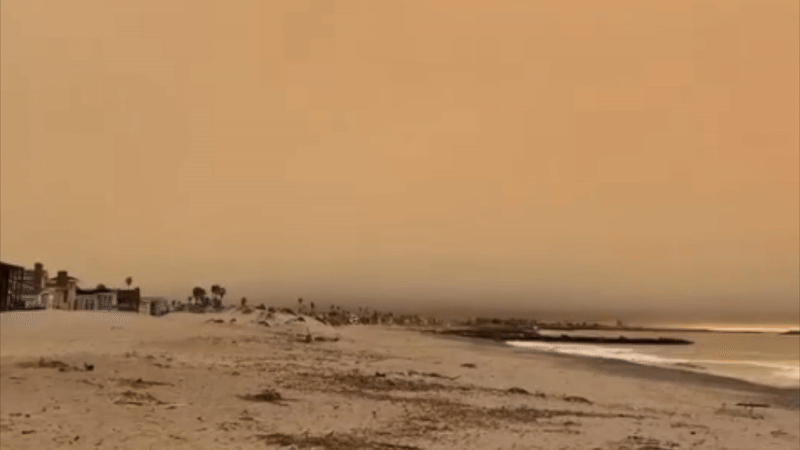When Nature Turns Dark: The Haunting Sepia Transformation of a Beach Amid Wildfire Smoke
In recent years, the world has witnessed a disturbing phenomenon: the dramatic transformation of landscapes engulfed in wildfire smoke. One particularly striking example is the eerie sepia-tone effect that envelops beaches when smoke from raging wildfires rolls in from nearby forests and grasslands. This haunting visual spectacle is not just a testament to the beauty of nature but also a stark reminder of its fragility amidst the growing specter of climate change.
Understanding the Eerie Aesthetic
As smoke from wildfires fills the air, it scatters and filters sunlight, resulting in a surreal ambiance. The light that reaches our eyes becomes tinged with shades of brown and orange, reminiscent of vintage photographs. This sepia transformation creates an otherworldly atmosphere that can be both beautiful and unsettling, invoking a sense of nostalgia while simultaneously highlighting a grave ecological crisis.
When we walk along a beach under these conditions, the vibrant blues of the ocean and sky fade into muted tones. The sand, usually a vibrant yellow or white, takes on a darker, more somber hue. This visual shift paints a picture of a world altered by environmental distress, reminding us of the delicate balance that sustains our ecosystems.
The Causes Behind the Transformation
To fully grasp why these sepia tones occur, we must first understand the mechanics of wildfire smoke. Wildfires release a complex mixture of gases and particulate matter into the atmosphere. These particles can travel vast distances, affecting air quality and visibility. When sunlight interacts with these particles, it scatters in a way that reduces the blue light spectrum, leading to warmer, earthier colors dominating the scene.
- Particulate Matter: Fine particles from burning vegetation can linger in the air, creating a haze that obscures clarity.
- Sunlight Scattering: The scattering of sunlight due to smoke alters the color spectrum, filtering out blues and greens.
- Humidity and Temperature: Atmospheric conditions can enhance the effects of smoke, making the sepia tones more pronounced.
The Environmental Impact
While the sepia-toned beaches might captivate photographers and nature lovers, they also underscore a more serious issue: the impact of climate change and human activity on our environment. The increasing frequency and intensity of wildfires can be attributed to several factors:
- Drought Conditions: Many regions are experiencing prolonged droughts due to climate change, creating tinderbox conditions for wildfires.
- Forest Management Practices: Poor forest management can exacerbate wildfire risks, allowing underbrush to accumulate fuel.
- Urban Expansion: As cities expand into wildland areas, the interface between human habitation and natural landscapes increases the risk of fire devastation.
In addition to the immediate visual changes, smoke from wildfires carries with it numerous health risks for those living nearby. Exposure to particulate matter and other pollutants can lead to respiratory issues, cardiovascular problems, and other long-term health effects.
Personal Reflections: Witnessing the Transformation
Experiencing a beach transformed by wildfire smoke is an unforgettable encounter. I recall visiting a coastal area during a particularly intense wildfire season. Upon arrival, I was struck by the stark contrast to the usual bright and inviting seaside atmosphere. The beach, once a vibrant palette of colors, had morphed into a haunting sepia landscape. The air was thick with smoke, and the sun hung low in the sky, casting an eerie glow over the water.
As I wandered along the shore, the sounds of the waves were muted, and the familiar scent of saltwater was replaced by a burnt, acrid smell. It was a poignant reminder of nature’s vulnerability; a moment where beauty and despair intertwined. The sepia tones of the beach became not only a visual phenomenon but also a symbol of the urgent need for environmental stewardship.
Raising Awareness and Taking Action
The haunting beauty of a sepia-toned beach should serve as a call to action for all of us. While the immediate aesthetic might evoke a sense of wonder, it also highlights the pressing issues of climate change and environmental degradation. Here are some steps we can take to combat these challenges:
- Support Sustainable Practices: Advocate for sustainable land management and forestry practices that reduce wildfire risks.
- Reduce Carbon Footprint: Take steps to lower your carbon footprint through energy efficiency, using public transport, and supporting renewable energy sources.
- Engage in Community Initiatives: Participate in local environmental organizations and initiatives aimed at protecting natural resources and habitats.
- Educate Others: Share insights about the impacts of climate change and wildfires with your community to raise awareness and inspire action.
Conclusion: Embracing Hope Amidst Change
The haunting sepia transformation of a beach amid wildfire smoke is more than just a captivating visual phenomenon. It serves as a powerful reminder of nature’s fragility and the urgent need to address climate change. While these images can evoke feelings of despair, they can also ignite hope and a sense of responsibility. By coming together as stewards of the environment, we can work towards preserving the beauty of our natural landscapes, ensuring that they remain vibrant and alive for generations to come.
In a world increasingly affected by climate change, the sepia tones that once might have seemed merely aesthetic now carry a weighty significance, challenging us to reflect on our role in the ecosystem and compelling us to act before more of our natural beauty fades into darkness.
See more Your Daily Weather



